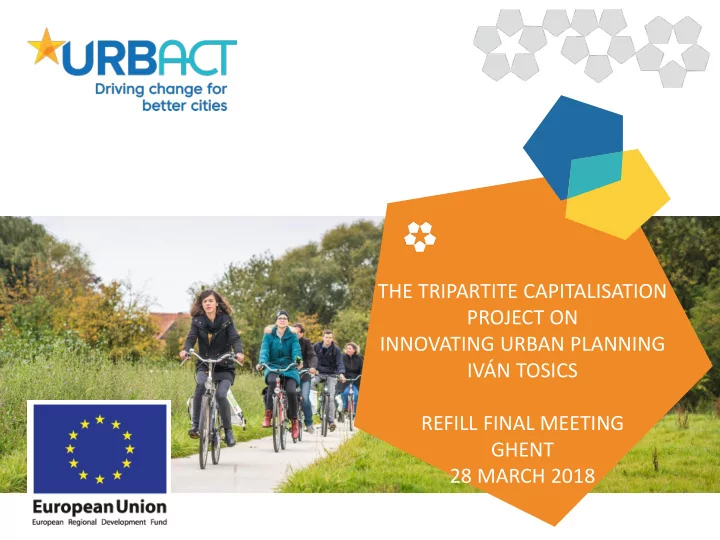

THE TRIPARTITE CAPITALISATION PROJECT ON INNOVATING URBAN PLANNING IVÁN TOSICS REFILL FINAL MEETING GHENT 28 MARCH 2018
Innovating urban planning • Due to the crisis the public sector has lost the steering role in urban development, both in power and in money. There is a need for a more flexible approach to assure integrated and inclusive development, based on opportunities given by spaces and by people • New types of tools have to be used to involve stakeholders which are not re-active any more to traditional tools of planning (e.g. master plans)
Need for new ways of thinking • A young lady becomes strategic advisor of the mayor and discovers that things are not going well: the private interests dominate urban development, there are dead areas in the city, people are inactive , sitting at home not thinking at all what to do. She wants to drop a stone into this water, finding ways how the public sector can again steer the development for the sake of public interests . • Her approach is not sitting in her office and writing reports but biking through the city and talking with different people, different stakeholders. Curiosity, accountability, engagement, innovative thinking, flexibility for new solutions, experimentation with the risk of failure before doing any prototype or practice. • Our webtool aims to be a Guide to inspirational cases…
URBACT projects: innovative cases Re-making a densely built-in transitory part of the city, to avoid further densification of the historical part: Antwerp, Lageweg. Big challenges: privately owned (10 private owners), polluted areas… Jumping between topics: spatial idea, financing, legal issues…
URBACT projects: innovative cases Create new empty places in the city as opportunity/space for experimentation about future activities: creative district, Ile de Nantes.
URBACT projects: innovative cases Use an empty building to start the change in a monofunctional part of the city: Brussels, European quarter.
The aim of the web-tool The aim is to put together good practices of URBACT cities into a logical order, illustrating innovative planning and city making examples according to two aspects: in regard of • new approaches to underused and/or problematic areas ( challenges ) • new ways of planning: engaging stakeholders, experiment , … ( tools ) The webtool should make it easy to cities to identify Good Practices which are close to their own challenges and also learn abour tools and procedures.
The type of the challenge A. Underused buildings B. Underused open spaces and areas C. Rundown and/or segregated areas D. Monofunctional areas E. Environmentally unsustainable areas/buildings
The process and tools for planning 1. Mapping 2. Action planning (through activation) – Envisioning (relating to public interest; involving policy makers; co-creating a vision) – Activating (initiating; promoting; involving/matchmaking/negotiating; communicating) – Experimenting (testing; incubating; developing step by step) 3. Decision-making and implementation – Decision-making – Financing (alternative financing) – Mainstreaming/institutionalizing (establishing agency; regulating; integrating management) 4. Impact assessment and reappraisal (Monitoring/evaluation/feed-back)
Mimicking in off-line form the future online webtool
The relevant good practices from 2nd Chance, Refill, Sub-urban and the URBACT Good Practices are included into the matrix
The importance/use of the web-tool In our opinion such a tool was missing up till now, which can attract the interest of a city to those innovative approaches which are addressing some of their specific problems. This targeted dissemination of good practices is a further step compared to the Results and the Good Practice publications to address the needs of the cities.
Timeline of further actions • Finalization of the offline version of the tool : on the basis of the three testing sessions • Web-design : to develop the online version of the webtool before the end of summer • URBACT City Festival (Lisbon, 13-14 September): presentation of the online web-tool • Road-show : to distribute the idea of the web-tool, making in that way cities interested in URBACT (promoting also the new APN call) and to collect their good practices. One full day meetings are planned, co-organized by the URBACT NUP-s, between September and November, in at least three countries. Potential countries: Romania or Bulgaria, Italy or Portugal or Greece and one more developed country (e.g. France) • Finalization of the online web-tool: a demonstration meeting in Brussels in early 2019.
Thanks for your attention! Ivan Tosics URBACT Programme Expert tosics@mri.hu
Recommend
More recommend